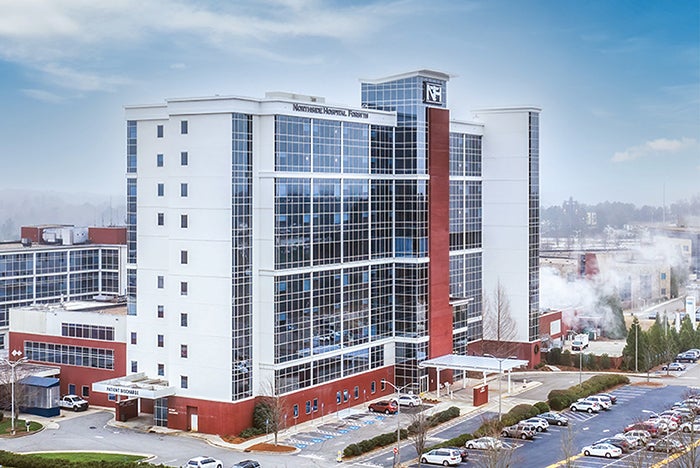Chiller optimization meets demand

Northside Hospital Forsyth uses Demand Flow chilled water optimization to reduce energy consumption and increase capacity.
Courtesy of Northside Hospital Forsyth
Northside Hospital Forsyth, located in Cumming, Ga., provides health care services with a patient-centered approach. The 389-bed hospital is staffed by 800 physicians and 3,700 employees.
As the organization continues to grow, so does the need to improve the overall reliability of its facilities, which operate 24/7. This is particularly true of Northside’s central plants. “Over the last few years, we have seen dramatic increases in our utility rates, especially in the summertime,” says Thomas W. Doenitz, system director of facilities operations.
Since 2021, Northside Hospital has worked with Siemens Smart Infrastructure Buildings, with North American operations based in the metropolitan Chicago area, to limit the energy consumption of its chilled water plants and to optimize their performance via Siemens’ patented Demand Flow solution.
To initiate an engineering analysis of its chilled water plant operations in 2021, the hospital provided Siemens with energy consumption and utility trend data for its two main central energy plants. Ultimately, Siemens engineers recommended the implementation of Demand Flow at both plants, alongside the installation of variable-frequency drives on all condenser and chilled water pumps, as well as the application of flow meters, differential pressure sensors, power meters and temperature sensors to support Demand Flow sequences of operation
The project also aimed to modify the interoperability of the two plants to help ensure optimal operations and better reliability. In addition, upgrades of the steam preheat control valves on 21 air-handling units would eliminate simultaneous heating and cooling.
Demand Flow optimizes water-cooled, central chilled water systems with centrifugal- or screw-type compressors using Siemens patented variable pressure curve logic (VPCL). VPCL algorithms couple with variable-speed drives installed on chilled water pumps, condenser water pumps and cooling tower fans to optimize system operation, ensuring building comfort and maximum energy savings.
An initial energy analysis revealed that the project could result in annual electrical savings of $111,000 and natural gas savings of $27,000. An additional utility incentive/rebate would reduce the overall project cost by $176,000, bringing the project’s payback period to 3.2 years. The hospital engaged a third-party commissioning agent to independently validate the Demand Flow solution prior to its implementation.
The facilities management team worked with the hospital’s internal communications team to ensure that everyone working in the hospital knew the project had started and to set appropriate expectations. Despite the team’s initial concerns about disruptions, Doenitz says the project’s implementation was “uneventful.”
Today, Northside Hospital Forsyth receives weekly reports detailing performance and operations within the central plant. The plant now consumes 21.6% less electricity, which is particularly important when considering that the organization now pays 9.7 cents per kilowatt-hour for electricity, compared to 5.3 cents when the project was initiated in 2021.
Also, improvements enabled by Demand Flow have contributed to a higher-than-expected utility incentive, reducing the initial project cost by $209,000 — about 19% better than projections. This combination of factors means that ongoing savings from Demand Flow are 6.5% better than expected, even in the face of higher utility costs.
Demand Flow has improved the hospital’s central plant redundancy as well. Whereas prior to the project, the central plant needed four operating chillers to deliver sufficient chilled water, today it can operate with two chillers.
“Redundancy like this is very important. If a chiller were to go down, it would be seamless for us to maintain our operations,” Doenitz explains. “Floods, fire and major equipment issues could be devastating for a hospital. That’s why having N+1 capacity for critical plant equipment is a goal for many health care organizations. We’ve effectively added chiller capacity through the improvements enabled by Demand Flow.”

